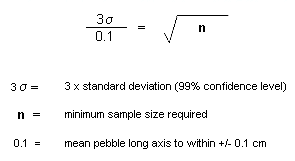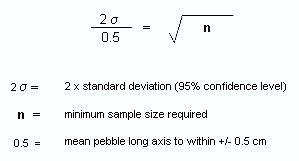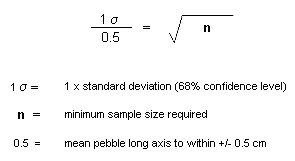|
The larger the size of the sample, the greater is the
probability that it accurately reflects the distribution of the parent
population. The example below shows how many pebble long axes are required to be
measured at a beach site to obtain an average (or mean) at the 99% confidence
level. The formula uses the standard deviation (the measure of the spread of
data around the mean).
What is the expected pebble long axes size distribution?
There are, as is well known, lies, damned lies and statistics.
And within statistics there is the bell curve. This is the shape of the
frequency distribution one gets when conducting measurements of just about
anything in the natural world.
It first came to prominence in the early nineteenth century
when Adolph Quetelet, the Belgian Astronomer Royal, collected data on the chest
measurements of Scottish soldiers and the heights of French soldiers, and found
that when both sets of measurements were plotted they tended to cluster in a
symmetrical shape around a mean. Or, less technically, most soldiers were in a
height range fairly close to the average. The bell curve became so ubiquitous in
measurements of natural phenomena that it was eventually christened the 'normal
distribution', and it has conditioned our thinking about statistical data ever
since.
The example below simulates how the random distribution of
dropping balls creates a bell-curve. At first there does not seem to be any
pattern but after a few minutes the stacks conform to the superimposed curve
|
Randomly dropping balls create a normal distribution curve
(bell curve)
|
What is the standard deviation?
The standard deviation is a statistic that tells you how
tightly the pebbles sizes are clustered around the mean. When the sizes are
tightly clustered and the distribution curve is steep (see graph below), the
standard deviation is small. When the examples are spread apart and the
distribution curve is relatively flat, that tells you that there is a relatively
large standard deviation.
Normal distribution curve (bell curve)
|
Key to graph colours above |
| Colour |
Standard Deviation |
% of Population |
|
|
One standard deviation away from the mean in either direction on
the horizontal axis |
68% |
|
|
Two standard deviations away from the mean |
95% |
|
|
Three standard deviations away from the mean |
99% |
Why is this useful?
Smaller standard deviations reflect more clustered data. More
clustered data means less extreme values. A data set with less extreme values
has a more reliable mean. The standard deviation is therefore a good measure of
the reliability of the mean value. The formula is as follows:
Is there an easy way to calculate it?
The Microsoft Excel programme will automatically
calculate the standard deviation and mean for a set of data listed in a
spreadsheet column.
Method:
- List data set in a single column
- Click on the empty cell below the last data item
- Open INSERT menu > FUNCTION > STDEV > click OK
- The standard deviation is then shown and will appear in the empty cell.
- The excel screen example below is for a data set of 3 items
The standard deviation for a pebble data set is shown
below:
|
30 pebble long axes, Beach 18, Sitges Site 1
|
|
Pebble number |
Long Axis (cms) |
|
1 |
10 |
|
2 |
9 |
|
3 |
8 |
|
4 |
8 |
|
5 |
16 |
|
6 |
12 |
|
7 |
8.5 |
|
8 |
10 |
|
9 |
12 |
|
10 |
9 |
|
11 |
13 |
|
12 |
14 |
|
13 |
10 |
|
14 |
14 |
|
15 |
17 |
|
16 |
12 |
|
17 |
6 |
|
18 |
17 |
|
19 |
9 |
|
20 |
5 |
|
21 |
10 |
|
22 |
7.5 |
|
23 |
13 |
|
24 |
13 |
|
25 |
7.5 |
|
26 |
15 |
|
27 |
12 |
|
28 |
8 |
|
29 |
22 |
|
30 |
16 |
|
Mean |
11.20 |
|
Standard Deviation |
3.81 |
|
A 99% sample size confidence level with a mean pebble long axis
within +/- 0.1cm is calculated using the following formula:
|

i.e. 11.43
0.1
= 114.3
n= 114.3²
Minimum sample required = 13,064 |
The time taken to measure over 13,000 pebbles suggests it is
better to accept a lower level of confidence, and at the 95% level, with a mean
pebble long axis within +/- 0.5 cm, a sample size of 30 is still inadequate.
This is calculated as follows:
|

i.e. 7.62
0.5
= 15.24
n= 15.24²
Minimum sample required = 232.26 |
You may, given time constraints, have to accept a 68% level of
confidence, with a mean pebble long axis within +/- 0.5 cm. The minimum sample
size is calculated as follows:
|

i.e. 3.81
0.5
= 7.62
n= 7.62²
Minimum sample required = 58.06 |
It is therefore necessary to measure a minimum of 58 pebble long
axes, given the pilot data at this site.
|